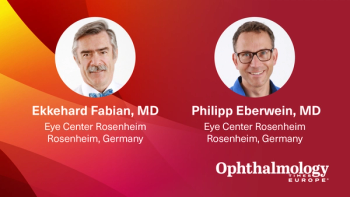
Part 4: The advantages of a digital workflow in modern cataract surgery
Modern cataract surgery has become a refractive procedure where patient satisfaction is driven by outcome precision. As others discussed previously, conducting a careful and thorough preoperative evaluation to optimize surgical planning combined with the use of a state-of-the art phacoemulsification system and high quality IOL are important elements for achieving outcome precision. In my opinion, streamlining all perioperative steps is also a crucial factor. In that regard, I have digitized my cataract surgery workflow, and I make use of the ZEISS EQ Workplace, which enables me to optimize outcomes while also increasing our workflow efficiency (Figure 8).
Figure 8. Streamlining my refractive cataract workflow with the ZEISS EQ Workplace
EQ Workplace is a digital workplace that provides connectivity between diagnostic and surgical devices, serving to ensure data accuracy and a more efficient refractive cataract workflow. Seamless data transfer, the opportunity for remote IOL calculation, and its automatic IOL ordering function makes the planning process more efficient for me and my practice staff, avoids the problem of lost paperwork, and prevents errors that can occur with manual data entry.
In my experience, the digital workplace also enhances OR efficiency, overall productivity, and surgical accuracy. Biometry measurements obtained with the IOLMaster 700, which include the posterior corneal surface for Total Keratometry, can be imported directly and seamlessly into FORUM, an ophthalmic data management solution from ZEISS that integrates into the existing IT infrastructure and connects with the electronic medical record system and DICOM and non-DICOM instruments. Surgeons can use the EQ Workplace to perform IOL power calculations that can be sent directly to CALLISTO eye (Figure 9). In addition, the information for each case, including patient name and selected IOL, will be displayed on the phacoemulsification platform screen, allowing visual data confirmation.
Figure 9. How to use EQ Workplace
Using EQ Workplace and FORUM, I can perform IOL calculations and pre-plan surgical assistance functions remotely (Figure 8), whether in the clinic, at home, or in a hotel room while traveling, as long as I have a VPN connection to my clinic network.
With this system I can select from different formulas to use for the IOL power calculations, and all of the calculations are performed with constants that are automatically updated from the IOLCon database. Using this digital tool for IOL calculation allows me to make informed decisions by reviewing a comprehensive and pre-populated view of all relevant diagnostic data. In addition, EQ Workplace is intended to avoid transcription errors that can occur during manual data entry and saves me time performing preoperative planning.
Once I have selected the appropriate IOL, I can use EQ Workplace to send an automatically generated email order for the lens, eliminating the potential for transcription errors occurring at that step. Relevant surgical planning information can also be automatically transferred to CALLISTO eye, increasing workflow efficiency and avoiding time spent in the OR entering the data (Figure 9).
Working with EQ Workplace
Following are situations I encountered in my daily practice that show the benefits of a fully integrated workflow using EQ Workplace.
We counsel all cataract surgery patients about the opportunity to reduce their need for glasses postoperatively, and patients interested in that option are evaluated with premium diagnostics to identify the most suitable IOL. Using EQ Workplace, we can automatically access their biometry data from the IOLMaster 700 via ZEISS FORUM and perform the IOL calculation directly on the spot. If a patient needs a toric IOL, the relevant data are seamlessly accessible in the system, and to verify the amount of toricity needed, we can double check the topography, Scheimpflug tomography, and other diagnostic parameters that are connected to FORUM and displayed in EQ Workplace. With data about spherical aberration, we can choose the right IOL to meet the individual’s needs. EQ Workplace allows us to make these decisions immediately with the patient sitting in the room whereas in the past it was necessary to go back to the IOLMaster to perform the calculations again and then print the results to select the intended IOL power. For presbyopia-correcting IOLs that are not kept in stock, calculations are reviewed by our trained team of specialists to ensure the best possible outcome. Then, the IOL order can be easily placed using the EQ Workplace automated ordering function.
For me, using EQ Workplace as part of my cataract workflow also helps with enhancing accuracy and efficiency in cases where an outside referring doctor performed the preoperative diagnostic evaluation. We frequently see such patients, and with FORUM and patient consent, referring doctors using the IOLMaster 500 or IOLMaster 700 can seamlessly transfer the biometric data into our system. IOL calculations for patients interested in IOLs that are in our consignment stock (monofocals, monofocal+ and EDoF IOLs with and without toricity) can even be performed in real-time in the operating theater, and if astigmatic correction is needed, the planning can be directly transferred into the CALLISTO eye software. If patients want a premium IOL outside of our consignment stock, their data are transferred in advance, giving us time to verify the information, do the calculation, and order the IOL so that the surgery can be scheduled in a timely manner with a fully automated data transfer to the CALLISTO eye for incision planning and toric alignment.
The benefits of EQ Workplace are also seen in situations where it becomes necessary to change from the planned IOL to a different model, perhaps because of an intraoperative complication. With EQ Workplace, the IOL calculation can be done on the spot to reduce delays and save costly OR time.
ZEISS EQ Workplace also offers personalization of IOL constants using the surgeon-specific results from previous surgeries (Figure 10). Non-optimized IOL constants account for sources of error that contribute to variable outcomes, but personalization is a task that some surgeons avoid because it requires time and effort. EQ Workplace software allows surgeons to perform IOL constant personalization in a simple and seamless way. Each patients’ results for corrected and uncorrected visual acuity, sphere, cylinder, and axis are entered into the post-op surveillance screen. Then, with the click of a button, the software incorporates the new information into the database and, when initiated by the surgeon, performs the personalization, updating the constants.
Figure 10. IOL Constant personalization with EQ Workplace
Enhancing my efficiency and outcomes with additional solutions
When it comes to efficiency in the OR, I believe that connectivity between the QUATERA 700 and CALLISTO eye and FORUM is another valuable asset (Figure 11). With the QUATERA 700, one single sterile cockpit becomes available that incorporates patient and surgical data, including patient name, IOL to be implanted, and phacoemulsification parameters. It also captures the microscope view and displays the intraoperative video live so that my entire surgical team can see in real-time what I am doing. Without having to turn their head to see a different monitor, surgical nurses share the surgeon’s view. By following the procedure as it progresses in real time, the surgical nurse assistant can anticipate the next steps and have the proper instrument or device ready for use when it is needed.
Figure 11. Integration of the phaco machine into the digital OR workflow
Regarding workflow optimization, I have also found potential benefit from ZEISS EYEGUIDE, another recently introduced digital solution. ZEISS EYEGUIDE is a new patient education app that makes information about cataracts and cataract surgery readily available to patients and their families, providing them with knowledge they can use to make informed decisions. My anecdotal impressions after implementing the app in one of our practices is that patients are more trusting of its content than they are of information they find on the Web using “Dr. Google” because EYEGUIDE is recommended by their provider while online information comes from an unknown source.
To help patients achieve a successful outcome by staying compliant during their cataract surgery journey, practices can also customize the content of the app by incorporating a pre-surgery checklist, and the app also features a patient-customizable tool for setting reminders about appointments and medication use. Details about the surgeon and the practice can be added as well, and we believe this information could work towards building patient trust and satisfaction with their surgical experience.
Using this patient education app also has a positive impact on our workflow efficiency. Patients who installed the app can access and begin to fill out online intake forms before their preoperative consultation visit. Also because patients are well-informed about cataract surgery and their options for pseudophakic correction via the app, the in-clinic counselling process is shortened.
Finally, another app, the ZEISS Surgery Optimizer application, is developed for surgeons as a new way of utilizing surgical videos to enable self-training and standardization of surgical techniques. I believe that this artificial intelligence-based solution can be especially useful for helping surgeons-in-training improve their technique. However, it can also support surgeons with any level of expertise who wish to refine their skills or when they are introducing new techniques or technology.
Conclusion
Modern cataract surgery has become a refractive procedure where patient satisfaction is driven by outcome precision. I believe that my implementation of new technologies from ZEISS, including the latest IOLs combined with digitalization, integration, and analysis of data used to plan, perform, and optimize the procedure, has raised my cataract surgery precision to a new level, reducing my surgery risks and enhancing my surgery outcomes. At the same time, these innovations have made our refractive cataract workflow seamless, simpler, and more efficient, allowing for a more relaxed and more enjoyable experience for me and my staff.
Supported by ZEISS
The statements of the authors reflect only their personal opinions and experiences and do not necessarily reflect the opinion of any institution with whom they are affiliated with. The authors alone are responsible for the content of their experience reported and any potential resulting infringements. Carl Zeiss Meditec AG and its affiliates do not have clinical evidence supporting the opinions and statements of the authors nor accept any responsibility or liability of the authors’ content.
The author Florian Kretz has a contractual or other financial relationship with Carl Zeiss Meditec AG and its affiliates.
Related Articles:
Newsletter
Get the essential updates shaping the future of pharma manufacturing and compliance—subscribe today to Pharmaceutical Technology and never miss a breakthrough.










































